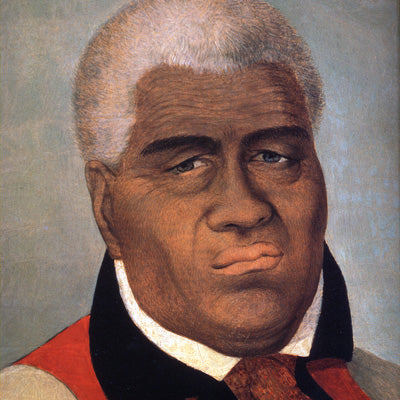History of the Kamehameha Garment Company and the Hawaiian Shirt
In the late 1920's, a tailor by the name of Ellery Chun cut out and sewed up a shirt from a bright, flowery piece of fabric he had laying around his King-Smith Tailor Shop. The shirt pattern he used was the one used to make the "palaka" (Hawaiian for "plaid") shirts that were traditionally worn by plantation workers in those days. He called it an "aloha shirt' and his shop quickly developed a following for the garments, which were then being sold for the princely sum of $1 a piece.
Aloha shirts caught the eyes of tourists, though his shop was somewhat off the beaten path of the typical Hawaii visitor. Service men stationed at Hawaii's several military bases also picked up on the item and began wearing them when their uniforms were not required.
When the visitors and service people began returning to the US Mainland sporting the garments, they began to be noticed by fashion industry people all over the country. May Company Department Stores were doing business with a garment cutter by the name of Herb Briner, an East coast transplant now living in California. They suggested to him that he take a trip to Hawaii and find out just what the fuss was about the new, brightly colored, casual men's shirts coming from the Islands.
What followed was the birth of The Kamehameha Garment Company, Hawaii's first wholesale ready-to-wear manufacturer. Briner booked a cabin on the Lurline and headed out for Hawaii. Two things happened during and immediately following the trip. He cultivated a shipboard romance with a fellow passenger, whom he would later marry and with whom he would have two sons. Upon arriving in Hawaii, he also fell in love with the Islands and would end up living there for the rest of his life. He also noticed the aloha shirts. Though Ellery Chun had trademarked the term, many other tailor shops jumped on the bandwagon and were making and selling them as fast as they could, dubbing them "Hawaiian shirts", the generic term still in use today.

Named for Hawaii's legendary King Kamehameha I, who united the island chain in 1795, The Kamehameha Garment Company established a reputation for quality and innovation that survived throughout the ensuing years.
Today, if one looks through the many books and articles that have been written about the Hawaiian fashion industry, the name Kamehameha will always be prominently mentioned. Indeed, original Kamehameha "silky" aloha shirts are prized by collectors of the genre, fetching hundreds, even thousands of dollars from antique clothing aficionados.
From its inception in 1936, the Hawaiian apparel business would wax and wane. The initial popularity of the garments in the late 30's would be interrupted, when Japan invaded China and cut off the supply of silk--the initial fabrication of choice because of the vibrancy of the color reproduction it lent itself to. To the rescue came the DuPont Corporation, who developed rayon, which became the de rigueur fabric for the production of the shirts as it had the same color reproduction and retention quality as did silk and an ability to wick away moisture that was superior to silk.
The end of World War II saw many soldiers, sailors and airmen returning from the Pacific via Hawaii and, again picking up and wearing home the signature island shirts. Harry Truman was featured on the cover of Life Magazine wearing one and they again began to ring cash registers at department stores and Haberdasheries nationwide. Arthur Godfrey wore them on his wildly popular TV show (on which, among other things, he strummed a ukulele) and that trended them again. Somewhat later, Elvis Presley would do the Movie "Blue Hawaii" in which he wore aloha shirts. This set off another craze featuring the shirts. Around Godfrey's time, a woman's garment, the mu’u mu’u, made its first mainland appearance and quickly became the feminine answer to the bright, printed shirts.
The 60's and the Hawaiian-inspired surfing craze (the sport was invented in Hawaii) saw the introduction of Jams, a type of surfing apparel introduced by Dave Rochlen's Surfline Hawaii. Rochlen, a California transplant, had seen a group of Russian sailors swimming in cut-off pajamas from whence he got the name and the style idea. His garments were soon featured on the cover of Life Magazine and he, himself, who among other things, taught Marilyn Monroe how to surf, became a legend and deservedly so. Twenty years after their first introduction, Jams resurged in the mid 80's. Rochlen's company would set the all-time record for sales by an island garment firm when, in 1985, they would ship $39.5 Million worth of Jams and associated apparel items. This, of course, caused renewed interest in the aloha shirt as the basic garment of the Hawaiian "look" and they boomed again.
The 70's had an aloha boomlet as well, with Rochlen and Surfline again creating a trend with their reverse print cotton aloha pullovers and their own brand of brightly printed aloha shirts which were beginning to be called "wearable art". The 70’s would see much "new blood" in the garment industry, as companies such as You and Me Naturally, Dano, Sunshine Hawaii, Brown Sugar of Hawaii, Kauaiana, Summer Daze, and others brought newer, more modern looks into the industry. But the old stand-by, the aloha shirt, held firm as the flagship of the Hawaiian apparel business. Indeed, Dano, a company that was noted for its stylish junior print wear, still did the bulk of their business in men's shirts from the same prints developed for their junior business.
The 1990's again saw a renewed interest in the garments, this time hugely influenced by a Japanese craze for anything Hawaiian. Their interest, combined with US national popularity of the Hawaiian look would fuel a years-long run of sales strength for the Hawaiian--or aloha--shirt, spearheaded by the original maker, The Kamehameha Garment Company.

